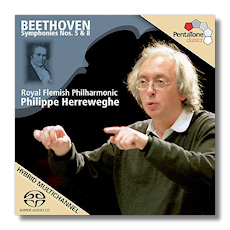
The Internet's Premier Classical Music Source
Related Links
- Beethoven Reviews
- Latest Reviews
- More Reviews
-
By Composer
-
Collections
DVD & Blu-ray
Books
Concert Reviews
Articles/Interviews
Software
Audio
Search Amazon
Recommended Links
Site News
 SACD Review
SACD Review
Ludwig van Beethoven

- Symphony #5 in C minor, Op. 67
- Symphony #8 in F Major, Op. 93
Royal Flemish Philharmonic Orchestra/Philippe Herreweghe
PentaTone Classics SACD PTC5186316
As I listened to the first movement of the Beethoven Fifth here, I thought Herreweghe, as usual, was leading a vital, lean, intense account of a classic. Everything was going along just splendidly. Then came the oboe cadenza, that quiet passage right at the end of the recapitulation and just before the coda (which begins with the "Tempo I" indication in the score). What did I hear? At first I couldn't say. It was like nothing I'd heard the oboe play before here. In the score, there are exactly ten notes to that passage. In this account there were half-again that many or more, and there was an upward turn added at the beginning.
Well, of course, it is called a quasi-improvisational cadenza, and therefore there is probably some precedent for this kind of elaboration – Herreweghe is an historic practices advocate, after all. But I've never come across anything like this before. All other Beethoven Fifths that I've heard – and, believe me, I've heard many – have featured those same ten notes performed the same way. The effect here is startling, even though the passage lasts just seconds. I can't say it disfigures the performance in any substantial manner, but I prefer the traditional way to play it. The rest of the symphony goes well, although the powerful chords that state the main theme in the opening of the finale are clipped, sounding a bit staccato-ish. Still, this approach fits Herreweghe's generally lean manner in this symphony. The orchestra, which sounds a tad undersized, even in the beefed-up finale, plays with great precision and spirit throughout. Overall, this is a fine, if controversial Beethoven Fifth then. I prefer Abbado and Harnoncourt among more recent versions, and maybe Szell and Jochum from the distant past, but Herreweghe is certainly compelling on his own terms.
The Eighth gets the same lean, spirited treatment, and here I have no complaints. The first movement, which goes at an extremely fast tempo is brilliantly conceived by Herreweghe and stunningly executed by his orchestra. This is much the way Abbado conducts this movement in his recording with the Berlin Philharmonic. In fact, Herreweghe conducts the whole work with extremely brisk tempos, placing this among the fastest Eighths ever put on record. To me, it's also easily one of the finest, as well. A+ for the Eighth then, and probably a B+ or A – for the Fifth. The sound in both works is vivid, though recorded at a slightly lower than usual level.
Copyright © 2008, Raymond Tuttle




















